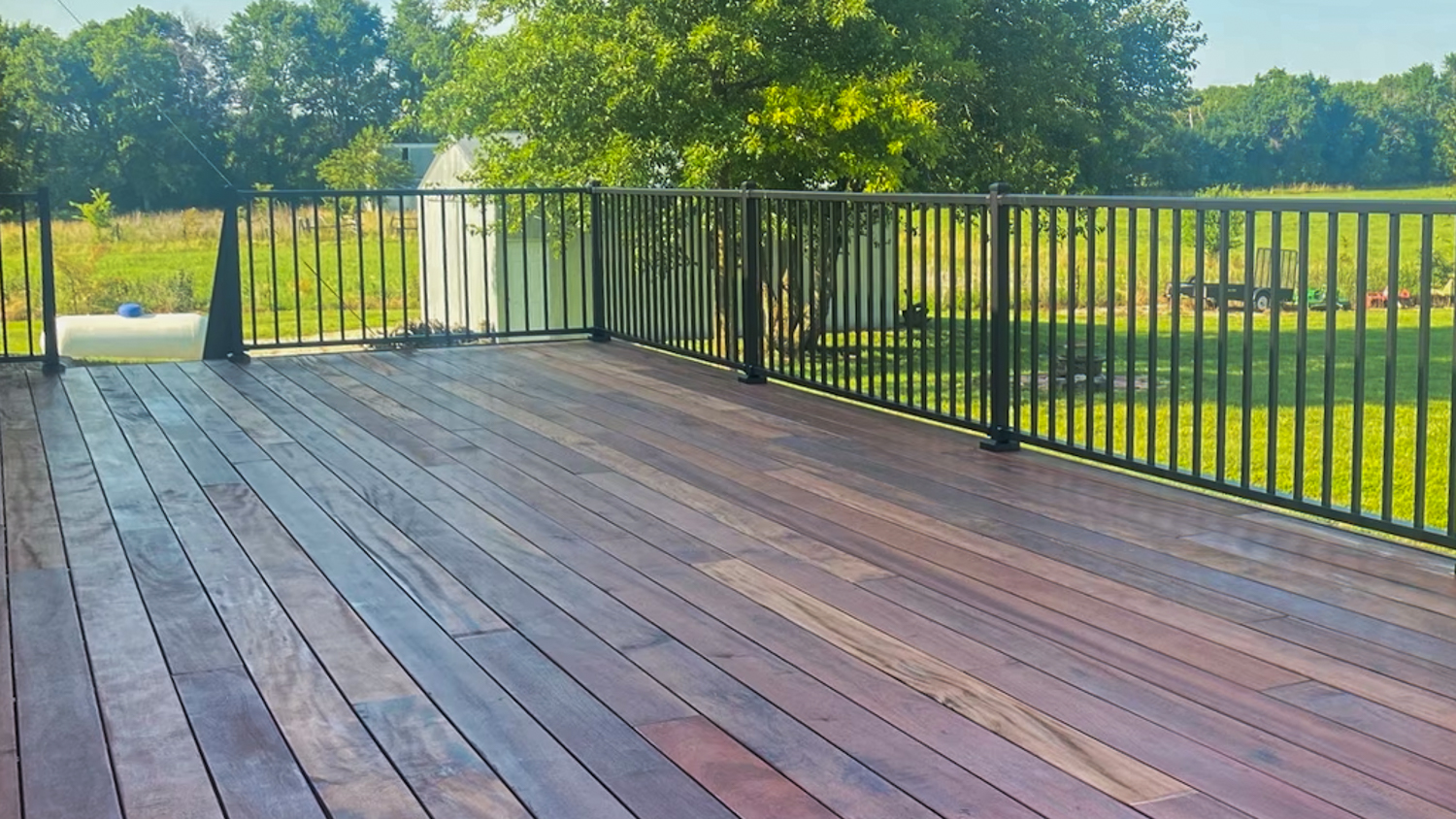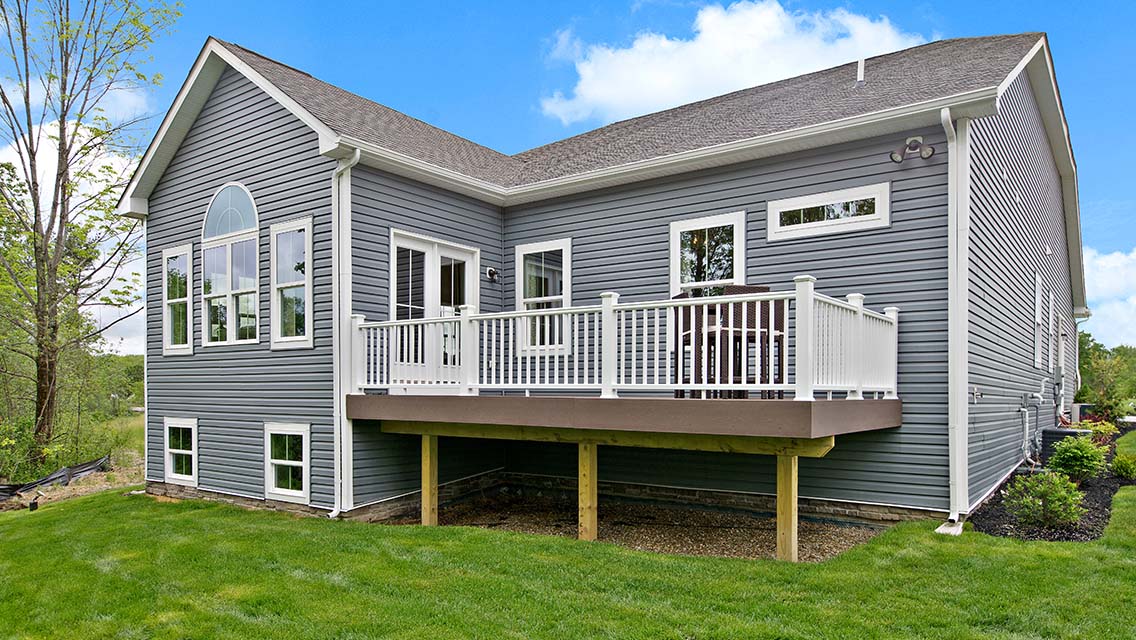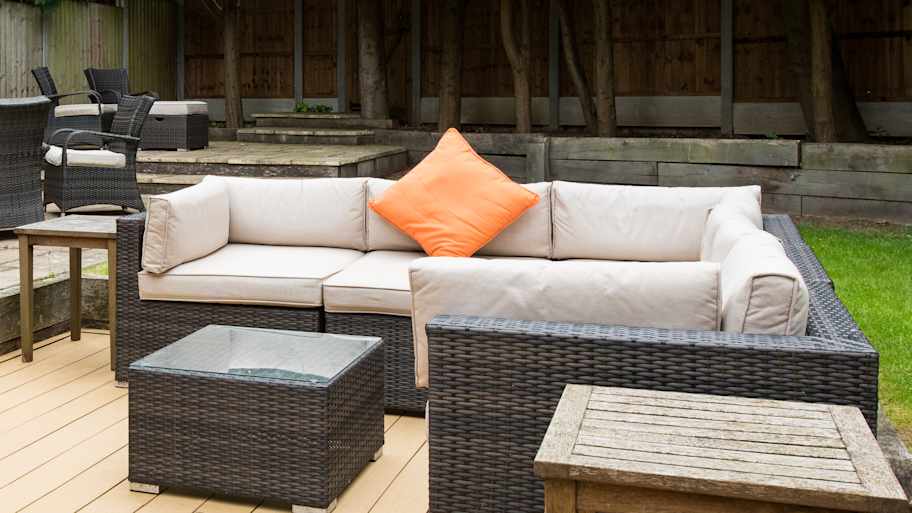
Trellises are structural pieces that add to your garden, but they can also add to your bills. Keep reading to find out how much a trellis costs to build.
Tigerwood decking installation costs an average of $9,500, with most homeowners paying between $7,500 and $12,000. Your price depends on deck size, material grade, and labor.


Tigerwood decking offers durability and exotic appeal.
Project size and material grade are major cost drivers.
Labor, permits, and custom features can increase the total price.
Professional installation ensures safety and long-term value.
Maintenance is essential for preserving tigerwood’s appearance.
This article was created using automation technology and thoroughly fact-checked and edited by an Angi Editor in accordance with our AI policy.
Tigerwood decking installation cost averages $9,500 for a standard project, with most homeowners spending between $7,500 and $12,000. Prices range from $30 to $70 per square foot, depending on deck size, material quality, and labor rates. Tigerwood’s unique look and longevity make it a premium decking choice.
Choosing tigerwood means investing in a deck that stands out for its natural beauty and resilience. This guide will help you understand all the costs involved, so you can plan your project with confidence.
Deck size is the single biggest factor impacting your tigerwood decking installation cost. The larger the deck, the more you’ll spend on materials and labor. Most homeowners build decks between 200 and 500 square feet, but costs can rise quickly for multi-level or complex layouts.
Expect to pay between $30 and $70 per square foot for tigerwood decking installation. Unusually shaped or multi-level decks increase costs due to extra framing and more intricate installation. To estimate your costs accurately, measure your deck’s length and width, then multiply them to get the total square footage. For decks with unique shapes, break the area into rectangles or triangles and add the totals together.
| Deck Size (Sq. Ft.) | Description | Average Installation Cost | Cost Range |
|---|---|---|---|
| 200 | Small | $7,000 | $6,000–$14,000 |
| 300 | Medium | $11,000 | $9,000–$21,000 |
| 400 | Large | $15,000 | $12,000–$28,000 |
| 500 | Extra large | $19,000 | $15,000–$35,000 |
Many elements influence the final price of a tigerwood decking installation. Let’s break down the main cost drivers so you know where your money goes.
Labor is a significant portion of your total cost for tigerwood decking installation. Local deck contractors, carpenters, and sometimes general contractors handle the job. Labor rates range from $8 to $20 per square foot or $50 to $100 per hour for skilled work with exotic woods like tigerwood.
Minimum service fees can make small projects less cost-effective, as many pros charge a base fee for site setup and travel. Labor costs also vary by location. Urban and high-cost-of-living areas see higher rates, while rural regions may be less expensive. Complex projects—such as multi-level decks or custom designs—require more time and expertise, raising labor costs. Labor often accounts for 40% to 60% of your total project budget.
Most municipalities require permits for new deck installations or major replacements. Permit fees range from $200 to $800, depending on your region and the project’s scope. New builds tend to have higher permit costs compared to simple repairs.
Contractors often handle permits for you, but homeowners are responsible in some areas. Additional fees may apply for required inspections, which can add another $100 to $300 to your total cost.
Adding custom features to your tigerwood deck can significantly affect your installation cost. Railings, stairs, and built-in elements such as benches or planters require extra materials and labor. Expect to pay $40 to $80 per linear foot for railings and $200 to $500 per step for stairs.
Lighting, electrical outlets, and other upgrades add to the budget. Custom design elements like inlays, patterns, or curved edges involve advanced skills and specialty hardware, increasing both material and labor costs. Hidden fasteners and high-end hardware—often recommended for tigerwood—are more expensive than standard options. Skirting, fascia boards, and finishing details also add to your final bill.
Several other factors can impact tigerwood decking installation costs:
Project complexity: Multi-level decks, irregular shapes, or custom layouts require more time and expertise.
Accessibility: Difficult-to-reach sites or limited access for materials and equipment increase labor and delivery costs.
Site preparation: Removing an old deck, grading, excavation, debris removal, and material delivery can add substantial costs.
Post-construction cleanup and disposal fees may be included or charged separately.
Design or architectural fees apply if you need custom plans.
Inspection costs may be required by your local building department before, during, or after installation.
Beyond the upfront installation price, there are several ongoing and one-time expenses to keep in mind.
Tigerwood decking often comes with manufacturer warranties covering defects in materials. These warranties last 20 to 30 years, but may exclude normal wear or poor maintenance. Contractors may offer workmanship warranties, covering one to five years.
You can purchase extended or third-party warranties for added peace of mind, with costs ranging from $200 to $1,000. Always review what is and isn’t covered before making a decision.
Operating costs for tigerwood decking include cleaning supplies, deck oils, and sealants. Annual upkeep supplies can cost $50 to $200, depending on the size of your deck. If you add lighting or electrical features, expect a slight increase in your utility bills.
Tigerwood requires regular maintenance to preserve its striking appearance. Plan to clean your deck at least twice a year and reseal it every one to three years. DIY annual maintenance may cost $100 to $300 for cleaners and sealers, while professional sealing services cost from $500 to $1,000 per year. Skipping maintenance leads to fading, warping, and costly repairs down the line.
Adding a new or high-value deck may increase your homeowner’s insurance premiums by a small amount. Check with your insurance provider to determine if your new deck is covered under your policy. Contractors should also carry liability insurance, which can affect their pricing but protects you during the project.
You have two main choices for installing tigerwood decking: tackle it yourself or hire a professional. Each option comes with its own set of costs and considerations.
For homeowners with strong carpentry skills, DIY tigerwood decking installation can save on labor. Expect to spend between $8,000 and $15,000 on materials for a 300-square-foot deck, depending on the grade of tigerwood and the hardware selected. You’ll need specialized tools—saws, drills, safety gear, and possibly hidden fastener systems, which can add $500 to $2,000 to your budget if you don’t already own them.
DIY projects can take several weekends and require careful planning. Tigerwood’s hardness makes cutting and fastening more difficult, raising the risk of mistakes like splitting boards or improper fastening, which can be costly to fix. Consider your skill level and available time before committing to a DIY project.
Hiring a professional adds labor and project management costs, but provides peace of mind. A pro will ensure your deck is built to code, meets warranty requirements, and looks its best. Professional installation for a 300-square-foot tigerwood deck may cost $11,000 to $21,000, including both materials and labor.
While hiring a pro is more expensive, you benefit from their expertise, access to better tools, and often a workmanship warranty. DIY is best for those with advanced carpentry experience, while most homeowners are better served by a professional tigerwood decking installation.
Knowing whether to repair or replace your tigerwood deck can save you money and extend your deck’s life.
Repairs are appropriate for minor damage, such as a few cracked or warped boards, loose fasteners, or small areas of surface wear. Repairing a single board costs $50 to $150, while small repairs run $300 to $1,000. If the underlying structure is sound, repairing is much more cost-effective than full replacement.
Replacement is needed if you see widespread rot, major structural issues, or if the deck is nearing the end of its life. Full deck replacement costs $9,000 to $25,000 or more, depending on size and design. If repair costs reach about 50% of the replacement price, replacement is often the better investment. Sometimes, replacing only the surface boards is possible if the frame is still solid.
| Project Type | Average Cost | Cost Range | Standard Scenarios |
|---|---|---|---|
| Repair | $500 | $300–$1,500 | Isolated board damage, minor surface issues |
| Replacement | $15,000 | $9,000–$25,000 | Widespread rot, structural failure, major wear |
Tigerwood decking can boost your home’s value, curb appeal, and outdoor enjoyment.
The ROI for tigerwood decking installation ranges from 65% to 75%, depending on your region and how well you maintain the deck. Tigerwood is less expensive than some exotics like ipe, yet it offers outstanding durability and beauty that appeals to homebuyers. A well-built tigerwood deck can be a strong selling point, particularly in areas where outdoor living is prized.
Deck size, quality of installation, and ongoing maintenance all influence your return. Higher-quality decks in desirable locations see the best ROI.
Beyond resale value, tigerwood decking improves safety by bringing your outdoor space up to code. You gain a more functional, attractive outdoor area for relaxation and entertaining. Features like ramps, wide steps, or built-in seating can make your deck more accessible for everyone. Tigerwood’s distinctive look and long-term durability add lasting enjoyment and value to your home.
There are several practical ways to keep tigerwood decking installation cost manageable:
Get multiple quotes from licensed, experienced decking contractors.
Choose standard deck shapes and sizes to minimize waste and labor.
Schedule installation during the off-season for potential discounts.
Handle demolition or site prep yourself if feasible and safe.
Opt for simpler railing and feature designs to reduce material and labor costs.
Maintain your deck regularly to avoid costly repairs or premature replacement.
Home is the most important place on earth, which is why Angi has helped more than 150 million homeowners transform their houses into homes they adore. To help homeowners with their next project, Angi provides readers with the most accurate cost data and upholds strict editorial standards. We extensively research project costs to develop the pricing data you see, so you can make the best decisions for you and your home. We rely on reputable sources, including the U.S. Bureau of Labor Statistics, academic journals, market studies, and interviews with industry experts—all to ensure our prices reflect real-world projects.
Want to help us improve our cost data? Send us a recent project quote to [email protected]. Quotes and personal information will not be shared publicly.
From average costs to expert advice, get all the answers you need to get your job done.

Trellises are structural pieces that add to your garden, but they can also add to your bills. Keep reading to find out how much a trellis costs to build.

Are your porch columns old or simply unsightly? It might be time to refresh them. Here's a breakdown of the cost of replacing porch columns.
Deck repair costs depend on materials, damage you need to fix, and more. See how much it costs to replace or repair a deck in Columbus, OH.

Still deciding between a terrace or a balcony for your home? Learn the pros, cons, and key differences to pick the perfect fit for your space.

Choosing from all the types of deck railing can be overwhelming. Check out the pros and cons of each so you can pinpoint the best option for you.

Many homeowners wonder, "Why are my deck boards warping?" Here are the most common causes, solutions, and the best steps for prevention.